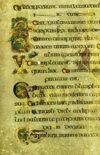Difference between revisions of "Template:Featured"
(Featured Article 3Feb07) |
|||
| Line 4: | Line 4: | ||
</div> | </div> | ||
<!--nb. portrait images at ~100px, landscape images at ~200px--> | <!--nb. portrait images at ~100px, landscape images at ~200px--> | ||
| − | [[Image: | + | [[Image:Bookofkells.gif|100px|left]]The '''Book of Kells''' represents the high point of manuscript [[Gospels]] produced in pre-Norman Britain. The Book of Kells, also known as the '''Book of Columba''' is an ornately illustrated manuscript Gospel that was produced around 800 by Celtic [[monk]]s. The test is written in Latin. |
| − | The | + | The Book of Kells is one of many Gospel manuscripts written from the late sixth century to the early ninth century in the [[Monastery|monasteries]] in Scotland, northern England, and Ireland. The Book of Kells was produced late in this period, perhaps around the beginning of the ninth century, and represents the high point in writing these artistic manuscripts. The manuscripts have been grouped by scholars based upon similarities in artistic style, script, and textual traditions. Among other surviving examples of this Biblical style are the Cathach of St. Columba, the Book of Durrow, the Durham Gospels, Lindisfarne Gospels, and the Macregal Gospels. |
| − | + | '''''Recently featured:''''' [[Archangel Gabriel]], [[Alexis of Wilkes-Barre]], [[Theophany]], [[Nativity]], [[Theological School of Halki]], [[Alexander Nevsky]], [[Episcopi vagantes]], [[Joseph the Hesychast]], [[Eucharist]], [[Alexander (Nemolovsky) of Brussels]]. ''Newly [[:Category:Featured Articles|featured articles]] are presented on '''Saturdays'''.'' | |
| − | '''''Recently featured:''''' [[Alexis of Wilkes-Barre]], [[Theophany]], [[Nativity]], [[Theological School of Halki]], [[Alexander Nevsky]], [[Episcopi vagantes]], [[Joseph the Hesychast]], [[Eucharist]], [[Alexander (Nemolovsky) of Brussels | ||
Revision as of 21:53, February 9, 2007
The Book of Kells is one of many Gospel manuscripts written from the late sixth century to the early ninth century in the monasteries in Scotland, northern England, and Ireland. The Book of Kells was produced late in this period, perhaps around the beginning of the ninth century, and represents the high point in writing these artistic manuscripts. The manuscripts have been grouped by scholars based upon similarities in artistic style, script, and textual traditions. Among other surviving examples of this Biblical style are the Cathach of St. Columba, the Book of Durrow, the Durham Gospels, Lindisfarne Gospels, and the Macregal Gospels.
Recently featured: Archangel Gabriel, Alexis of Wilkes-Barre, Theophany, Nativity, Theological School of Halki, Alexander Nevsky, Episcopi vagantes, Joseph the Hesychast, Eucharist, Alexander (Nemolovsky) of Brussels. Newly featured articles are presented on Saturdays.
